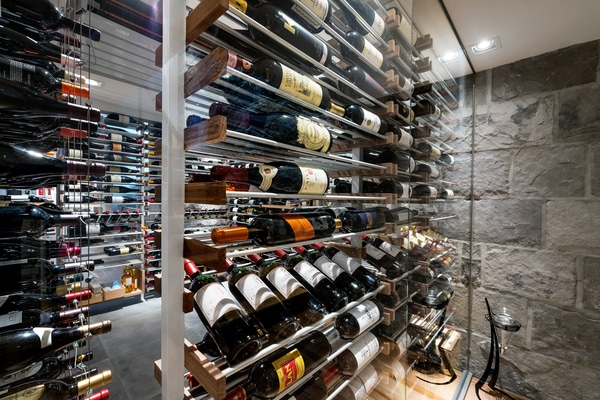
Red wines, white wines, rosé wines, champagnes, naturally sweet wines… not all wine categories should be enjoyed at the same temperature. However, to ensure optimal preservation and an aging process that allows the wine to improve over the years, it is important to maintain a certain temperature in your wine cellar.
Ideally, the desired temperature in a wine cellar should be a constant 12 degrees Celsius, avoiding any fluctuations. In reality, while it is difficult to maintain the temperature of a cellar to the nearest degree, a range between 10 and 14 degrees Celsius is acceptable without compromising the improvement and preservation potential of your precious nectars.
How does an incorrect storage temperature affect wine?
Of all the requirements a wine cellar worthy of the name must meet, maintaining an ideal temperature is certainly the most important criterion, along with humidity.
A wine stored in an environment that’s too warm will age much more quickly and won’t give the tannins time to improve. You then run a high risk of opening and tasting a bland wine or one that falls far short of your expectations when you don’t discover that the wine has deteriorated.
Excessive storage temperatures will directly affect the wine’s aromas, with a sensation of cooked fruit or caramelization. Damage can also be seen in the cork, which expands and exposes the wine to the risk of oxidation, making it unfit for consumption.
On the other hand, if the temperatures in your wine cellar are too cold, you risk seeing your wine’s maturation stop and you won’t benefit from aging it—quite the opposite, in fact.
At what temperature should wine be served?
When it comes to wine cellars, you must distinguish between different types of space layouts depending on your objectives. For example, an aging cellar will allow the wine to improve, while a serving cellar or wine cabinet will allow the bottles to be placed at the optimal temperature for wine tasting.
Millesime Wine Racks offers some expert advice for serving wine at the right temperature:
White Wines
Between 7 and 8 degrees Celsius for champagnes, naturally sweet wines, and sparkling wines in general.
Between 9 and 10 degrees Celsius for late-harvest Alsace wines or sweet wines.
Between 11 and 12 degrees Celsius for dry white wines, noble wines, vintage champagnes, or sweet grand cru wines.
Between 13 and 14 degrees Celsius for yellow wines or renowned dry white wines.
Between 15 and 16 degrees Celsius for white wines from a strong vintage.
Rosé Wines
Between 7 and 8 degrees Celsius for rosé champagnes and other sparkling rosé wines.
Between 9 and 10 degrees Celsius for light rosés known as “thirst-quenching” rosés.
Between 11 and 12 degrees Celsius for classic rosés or vintage rosé champagnes. From 13 to 14 degrees Celsius for rosé Burgundy, claret wines, or fuller-bodied rosés.
Red wines
11 to 12 degrees Celsius for fruity red wines.
Between 13 and 14 degrees Celsius for Beaujolais or naturally sweet wines.
From 15 to 16 degrees Celsius for Loire, Rhône, and Burgundy wines.
From 17 to 18 degrees Celsius for Bordeaux and all other red wines or Port-type wines.
Up to 19 to 20 degrees Celsius for grands crus, more elaborate wines, or great vintages.

Europea Wine Racks designs premium modular wine racks with the Millésime collection, combining elegant design, flexibility, and optimal wine preservation.
Solutions tailored for both private individuals and professionals.
© 2013-2025 Europea Wine Racks